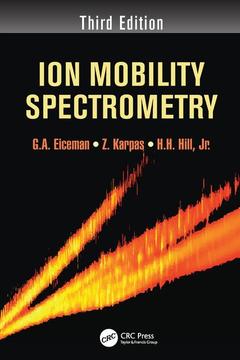Description
Ion Mobility Spectrometry (3rd Ed.)
Authors: Eiceman G.A., Karpas Z., Hill Jr. Herbert H.
Language: English
Subject for Ion Mobility Spectrometry:
Keywords
IMS; Drift Tube; drift; IMS Analyzer; tube; Drift Tube IMS; analyzers; Mobility Spectrometers; spectrometers; Mobility Spectra; spectrum; Ion Mobility; spectrometer; Electric Eld; time; Drift Gas; electric; Ion Mobility Spectrometry; eld; FAIMS; mass; Ion Swarm; Ion Shutter; Ion Mobility Spectra; Drift Region; Protonated Monomer; IMS Instrument; DMA; Buffer Gas; Mobility Coefcient; Drift Time; Collision Cross Section; Faraday Plate; Drift Rings; IMS Technology
99.36 €
In Print (Delivery period: 14 days).
Add to cartPublication date: 11-2016
· 15.6x23.4 cm · Paperback
220.72 €
In Print (Delivery period: 15 days).
Add to cartPublication date: 11-2013
500 p. · 15.6x23.4 cm · Hardback
Description
/li>Contents
/li>Readership
/li>Biography
/li>
Since the turn of the twenty-first century, applications of ion mobility spectrometry (IMS) have diversified, expanding their utility in the military and security spheres and entering the realms of clinical practice and pharmaceutical exploration. Updated and expanded, the third edition of Ion Mobility Spectrometry begins with a comprehensive discussion of the fundamental theory and practice of IMS. Divided into four sections?Overview, Technology, Fundamentals, and Applications?the authors treat innovations and advances in all aspects of IMS in a fresh, thorough, and revised format.
Features:
Mobility-based methods are no longer restricted to volatile substances and indeed the many benefits of this technology?simplicity, convenience, and the low cost of technology?have become recognized as meritorious in a wide range of uses. This is also true for the advantages of measurements?high speed, distinctive spectral features, and operation in ambient pressure with thermalized ions. Ion Mobility Spectrometry, Third Edition serves specialists in the field of IMS who are interested in the potential of recent developments and researchers, engineers, and students who want a comprehensive overview of this technology.
Introduction to Ion Mobility Spectrometry. History of Ion Mobility Spectrometry. Sample Introduction Methods. Ion Sources. Ion Injection and Pulsed Sources. Drift Tubes in Ion Mobility Spectrometry. Ion Detectors. The Ion Mobility Spectrum. Ion Mobility-Mass Spectrometry. Ion Characterization and Separation: Mobility of Gas Phase Ions in Electric Fields. Control and Effects of Experimental Parameters. Detection of Explosives by IMS. Chemical Weapons. Drugs of Abuse. Pharmaceuticals. Industrial Applications. Environmental Monitoring. Biological and Medical Applications of IMS. Current Assessments and Future Developments in Ion Mobility Spectrometry.
G.A. Eiceman is a professor at New Mexico University in Las Cruces.
Z. Karpas is an associate at the Nuclear Research Center in Beer-Shev, Israel.
Herbert H. Hill is a professor at Washington State University in Pullman.




